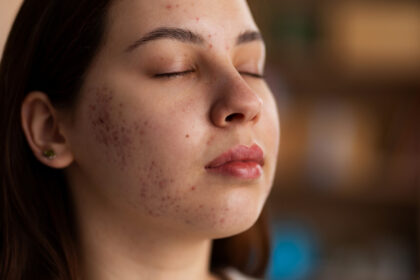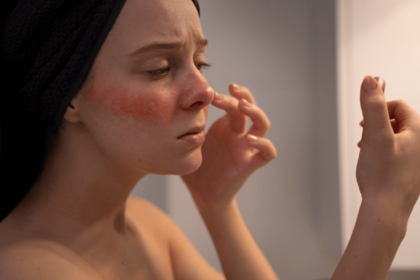Rosacea is a chronic skin condition that primarily affects the face, causing redness, flushing, visible blood vessels, and in some cases, bumps and pimples.
It often develops in adulthood and tends to affect people with fair skin.
While the exact cause is unknown, factors like genetics and environmental triggers may contribute.
Ocular Rosacea, on the other hand, is an extension of Rosacea that specifically involves the eyes.
In addition to the skin symptoms, individuals with Ocular Rosacea may experience eye-related issues such as redness, dryness, burning, itching, sensitivity to light, and, in severe cases, vision problems.
It’s important to note that Ocular Rosacea can occur independently of skin symptoms, making it a distinct but related condition.
Both Rosacea and Ocular Rosacea can have a significant impact on an individual’s quality of life, and management often involves a combination of lifestyle adjustments.
Causes
The exact cause of Ocular Rosacea is not well understood, but it is believed to be related to the underlying factors that contribute to skin Rosacea.
Some possible causes and contributing factors include:
Dysfunction of Meibomian Glands
Meibomian glands, which are responsible for producing the oily part of tears, may malfunction in individuals with Ocular Rosacea. This can lead to issues like dry eyes.
Inflammation
Inflammation is a common factor in both skin and eye symptoms of Rosacea.
Chronic inflammation can affect the blood vessels in the eyes, leading to redness and irritation.
Demodex Mites
These microscopic mites that normally inhabit facial skin may be more abundant in individuals with Rosacea.
Some studies suggest a potential link between these mites and Ocular Rosacea.
Genetics
There may be a genetic component, as Rosacea tends to run in families.
If you have close relatives with Rosacea, you may be at a higher risk.
Environmental Triggers
Certain environmental factors, such as sun exposure, wind, heat, and spicy foods, are known to trigger or worsen Rosacea symptoms, including those affecting the eyes.
Immune System Abnormalities
Some researchers believe that abnormalities in the immune system may contribute to the development of Rosacea, including its ocular manifestations.
Symptoms
Ocular Rosacea can manifest with various symptoms affecting the eyes.
These symptoms may vary in severity and can include:
Redness
Redness of the eyes is a common symptom, giving the eyes a bloodshot appearance.
Dryness
Individuals with Ocular Rosacea often experience dry eyes, which can lead to discomfort, a gritty sensation, or a feeling of something foreign in the eyes.
Burning or Stinging
Many people with Ocular Rosacea report a sensation of burning or stinging in their eyes.
Itching
Eyes affected by Ocular Rosacea may itch, contributing to further discomfort.
Sensitivity to Light (Photophobia)
Increased sensitivity to light is a common symptom. Bright lights may cause discomfort or pain.
Blurred Vision
In severe cases, Ocular Rosacea can lead to blurred vision or difficulty focusing.
Tearing
Paradoxically, some individuals may experience excessive tearing as the eyes attempt to compensate for dryness.
Swelling
Swelling of the eyelids or the surrounding eye area can occur, especially during flare-ups.
It’s important to note that Ocular Rosacea symptoms can occur independently of skin symptoms, but they often coexist.
Complications
Ocular Rosacea, if left untreated or inadequately managed, can lead to several potential complications.
These complications can impact both the eyes and vision.
Here are some possible complications associated with Ocular Rosacea:
Corneal Damage
Chronic inflammation and dryness can contribute to damage to the cornea, the transparent front part of the eye.
Corneal damage may lead to vision disturbances, including blurred vision and sensitivity to light.
Conjunctivitis
Inflammation of the conjunctiva, the thin layer covering the whites of the eyes and the inner eyelids.
Conjunctivitis can cause redness, itching, and increased tearing.
Corneal Neovascularization
It’s an abnormal blood vessel growth in the cornea.
This can affect the transparency of the cornea and may lead to vision problems.
Recurrent Styes or Chalazia
It’s Inflammatory bumps or cysts on the eyelids.
Recurrent styes or chalazia can be uncomfortable and affect the overall health of the eyelids.
Meibomian Gland Dysfunction
Dysfunction of the Meibomian glands, which produce the oily part of tears.
This can contribute to chronic dry eyes and discomfort.
Decreased Visual Acuity
This Includes a reduction in the clarity of vision.
Ocular Rosacea, if not effectively managed, can lead to long-term vision problems.
Secondary Infections:
Due to the compromised barrier function of the eyes.
They can exacerbate inflammation and lead to more severe complications.
Early diagnosis and proper management can help prevent or minimize these potential complications and improve the overall prognosis.
Regular follow-ups with eye care professionals are essential for monitoring and adjusting the treatment plan as needed.
Treatments
Here are five treatments commonly used for Ocular Rosacea:
Artificial Tears and Lubricating Eye Drops
Artificial tears and lubricating eye drops play a crucial role in the treatment of Ocular Rosacea by addressing the dryness and discomfort associated with the condition.
Artificial tears are formulated to mimic the composition of natural tears.
They contain lubricating ingredients such as water, electrolytes, and sometimes viscosity-enhancing agents.
Ocular Rosacea often leads to dry eyes, where the eyes do not produce enough tears or the tears evaporate too quickly.
Artificial tears provide essential moisture, relieving the dryness and improving overall eye comfort.
Lubricating eye drops help reduce irritation and redness by soothing the ocular surface.
Artificial tears provide immediate relief by soothing the eyes and reducing these discomforting symptoms, contributing to better overall eye health during periods of increased inflammation.
It’s important to note that while artificial tears and lubricating eye drops provide symptomatic relief, they are often part of a broader treatment plan for Ocular Rosacea.
Lid Hygiene
Proper lid hygiene involves cleaning the eyelids and lashes to manage symptoms and prevent complications.
Maintaining good eyelid hygiene contributes to the overall health of the eyes.
Consistent lid hygiene serves as a preventative measure, reducing the frequency and severity of flare-ups and contributing to the long-term management of Ocular Rosacea.
This may include warm compresses and gentle cleaning with baby shampoo or specialized eyelid cleansers.
Lid hygiene helps reduce inflammation, control bacterial colonization, and improve the overall health of the eyelids.
Healthcare providers often provide specific instructions on the frequency and technique for lid hygiene, which may vary based on the individual’s needs.
Cyclosporine Eye Drops
Cyclosporine eye drops are immunomodulatory medications that may be prescribed to reduce inflammation and improve the quality of tears in individuals with Ocular Rosacea.
Cyclosporine helps modulate the immune response on the ocular surface, reducing inflammation and promoting better tear production.
These eye drops are typically applied twice daily, and it may take several weeks to see the full effects. Regular follow-ups with a healthcare provider are essential to monitor progress.
It’s important to note that treatment plans for Ocular Rosacea should be tailored to the individual, and healthcare providers may recommend a combination of these approaches for optimal management.
Regular follow-ups and open communication with a healthcare professional are crucial to monitor progress and make adjustments as needed.
It’s important to follow the guidance of healthcare providers and incorporate lid hygiene into a comprehensive treatment plan for Ocular Rosacea.
Prevent Ocular Rosacea
Ocular rosacea can be tricky to manage, but here are a few tips that might help:
Keep your eyes clean
Regularly cleaning your eyes helps reduce the bacterial load, minimizing the risk of bacterial overgrowth and related symptoms associated with Ocular Rosacea.
Keeping your eyes clean can help prevent the overgrowth of Demodex mites, reducing their potential impact on the skin and eyes.
Cleaning the eyelids helps prevent inflammation along the lid margins, reducing the risk of blepharitis and related discomfort.
Establishing a simple and consistent eye hygiene routine involves using a gentle cleanser or lid wipes as recommended by healthcare professionals
Warm compresses
Applying warm compresses to your closed eyes for about 10-15 minutes can help soothe symptoms and reduce inflammation.
Warm compresses provide gentle heat to the eyelids, helping to soften the hardened oil in the Meibomian glands.
This can improve the flow of oils, promoting healthier tears and preventing complications such as dry eyes.
The heat from warm compresses assists in loosening and removing these irritants, reducing the risk of inflammation and discomfort associated with Ocular Rosacea.
Be sure the compress is clean to avoid introducing additional irritants.
To use warm compresses effectively, follow these steps:
- Soak a clean cloth or cotton pad in warm (not hot) water.
- Gently place the warm compress over closed eyes for 5 to 10 minutes.
- Repeat the process as needed, ensuring the compress remains warm.
Avoid triggers
Identify and try to avoid factors that trigger your ocular rosacea symptoms.
Avoiding triggers is a proactive strategy that can significantly contribute to preventing the onset or exacerbation of Ocular Rosacea.
Common triggers include spicy foods, hot beverages, alcohol, and exposure to wind and sunlight.
By avoiding these triggers, you reduce the risk of excessive blood vessel dilation in the eyes, which is often associated with the redness characteristic of Ocular Rosacea.
By being mindful of potential triggers and making lifestyle adjustments to avoid them, individuals can significantly reduce the frequency and severity of Ocular Rosacea symptoms.
Protect your eyes
Wear sunglasses that block UV rays to shield your eyes from the sun and wind.
Wearing sunglasses that block both UVA and UVB rays helps reduce the inflammation that can contribute to the condition.
The skin around the eyes is delicate and prone to irritation.
UV protection, especially in the form of sunglasses, helps prevent sun damage to this sensitive area and can reduce the risk of triggering ocular rosacea symptoms.
Manage stress
Stress management plays a crucial role in preventing ocular rosacea because stress is a known trigger for flare-ups.
Keeping stress levels in check may help maintain hormonal balance and reduce the risk of hormonal triggers for ocular rosacea.
Taking steps to manage stress, whether through meditation, yoga, or other relaxation methods, contributes to better overall well-being and may indirectly support ocular health.
Consult with a professional
Work closely with your eye care professional or dermatologist to develop a personalized treatment plan. They may prescribe medications or other interventions based on the severity of your symptoms.
Extra Tips for healthy eyes
Here are some additional tips for maintaining healthy eyes:
Follow the 20-20-20 rule
The 20-20-20 rule is a simple but effective practice to help keep eyes healthy, especially in the digital age where many people spend extended periods looking at screens.
The rule is as follows: every 20 minutes, take a 20-second break, and look at something 20 feet away.
Incorporating the 20-20-20 rule into your screen time routine is a simple yet effective way to promote eye health and reduce the negative effects associated with prolonged digital device use.
Stay hydrated
Staying hydrated is essential for overall health, and it also plays a crucial role in maintaining healthy eyes.
To support eye health, aim to drink an adequate amount of water throughout the day.
The recommended daily water intake varies for individuals, but a general guideline is to consume about eight 8-ounce glasses of water a day.
Adjust your intake based on factors like climate, physical activity, and individual hydration needs.
Eat an eye-friendly diet
Consume foods rich in vitamins and nutrients that promote eye health, such as leafy greens, fish high in omega-3 fatty acids, and colorful fruits and vegetables.
Quit smoking
Smoking is linked to an increased risk of developing age-related macular degeneration (AMD) and other eye conditions.
Quitting can contribute to better eye health.
Get regular exercise
Regular physical activity is not only good for your overall health but can also benefit your eyes.
Exercise improves blood circulation, which can help prevent conditions like glaucoma.
Protect against computer vision syndrome
Adjust your computer screen to be at eye level and ensure proper lighting to reduce eye strain.
Consider using an anti-glare screen or wearing blue light blocking glasses if you work on a computer for extended periods.
Check your family history
Some eye conditions have a genetic component.
Knowing your family’s eye health history can help you be proactive in managing your own eye health.
Remember, a holistic approach to health, including a well-balanced lifestyle and regular eye check-ups, is key to maintaining good eye health.
Conclusion
Ocular Rosacea poses unique challenges as it intertwines with the broader spectrum of Rosacea symptoms.
Recognizing the distinct signs, such as redness, dryness, and sensitivity to light, is crucial for early intervention.
The multifaceted nature of Ocular Rosacea demands a comprehensive approach to treatment.
Artificial tears, serving as a frontline defense against dryness, alleviate discomfort and foster better tear production.
Lid hygiene emerges as a pivotal component, promoting ocular health by curbing inflammation and fostering optimal eye conditions.
FAQs
What is Ocular Rosacea?
Ocular Rosacea is a condition that involves inflammation of the eyes and eyelids, often occurring alongside skin symptoms of Rosacea.
How can Artificial Tears help with Ocular Rosacea?
Artificial Tears provide moisture to alleviate dryness and discomfort in the eyes associated with Ocular Rosacea.
Why is regular eye hygiene important in Ocular Rosacea prevention?
Regular eye hygiene removes irritants, prevents bacterial overgrowth, and contributes to overall eye health, reducing the risk of Ocular Rosacea.





